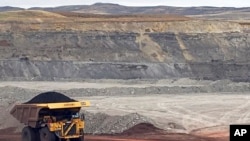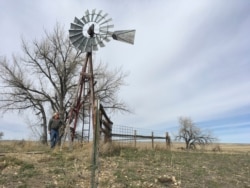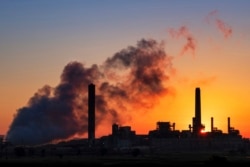It was a sobering moment this July 1 in Gillette, Wyoming, when two of the largest coal mines in the country closed in midshift.
Melissa Peterson Worden was one of about 600 people who lost their jobs that day, when the nation’s sixth-largest coal mining company, Blackjewel, abruptly went out of business.
“It is the thing they said would never happen,” Worden said. “And it happened.”
Blackjewel had applied for bankruptcy protection that morning. But the company couldn’t get funding to keep the mines running while courts sorted out its finances. So the mines closed that afternoon. They haven’t opened since.
Blackjewel’s bankruptcy underscores the paradigm shift taking place in the electric power industry. In just the last decade or so, more than half of the nation’s 530 coal-fired power plants have shut down or announced plans to do so as cheaper, cleaner alternatives have moved in, according to the Sierra Club.
While the downturn in the coal industry has hit hard in the Eastern U.S. region of Appalachia, Wyoming is the nation’s largest coal producer by far. The state dug more than 316 million tons of coal in 2017, more than all seven states of Appalachia combined.
Companies with mines in Wyoming’s Powder River Basin were thought to have “jewels in their balance sheets,” said Robert Godby, director of the University of Wyoming’s Center for Energy Economics and Public Policy, “because the Powder River Basin was so profitable.”
“But that’s changed in a few short years,” he added. “The tide has just turned so quickly that it’s caught a lot of people off guard.”
Rock bottom prices
Even as the coal industry faltered elsewhere, the Powder River Basin thought it would weather the downturn.
Coal is so easy to mine in Wyoming’s Powder River Basin, the local joke goes, that all you need is a golf club. Huge seams lie just below the surface.
The mines are massive. Seven of the 10 largest mines in the country are here. Dump trucks the size of houses carry 400 tons of coal at a time through terraced craters carved out of the grasslands.
The huge economies of scale meant coal from these mines was among the cheapest in the country. The state supplies 40% of the nation’s coal, fueling power plants from Georgia to Oregon.
Coal’s backers blame the Obama administration environmental regulations for closing plants that have kept the lights on for generations.
But experts say the decline has more to do with the rapid rise of cheaper natural gas since the mid-2000s. And the plunging cost of solar and wind power in just the last few years is helping renewable energy further cut into coal’s market.
That’s forcing a reckoning in places like Gillette, Wyoming, the de facto capital of the Powder River basin.
Change comes to the ‘energy capital’
Mining is “kind-of a family thing” for Rory Wallet.
His father, stepfather and sister all have worked in the coal mines around Gillette, he said. His grandfather was a phosphate miner before that.
“It’s a wonderful way to make a living. A decent, livable living,” he said. “I’ve got four kids, so it’s a great way to keep them insured and keep food on the table and keep a good home over their head.”
But Wallet lost his job in the Blackjewel bankruptcy.
“We’re struggling,” he said. “The big one for us is the house payment.”
He’s kept up his spirits and those of hundreds of others with a Facebook page that’s become a de facto support group for former Blackjewel workers.
Mining is a high paying job with good benefits that doesn’t require higher education. When mining jobs dry up, experts say, it’s hard to find a substitute.
That poses a problem for Gillette, population 30,000. The city bills itself as the “Energy Capital of the Nation.”
While Gillette and Wyoming are profiting from oil and gas development, those industries tend to boom and bust. Coal has been a relatively steady source of tax revenue for decades.
“Coal has built the city as you see it,” said Gillette Mayor Louise Carter-King.
Gillette has weathered previous downturns. But the mayor sees the coal industry is on a downward trajectory.
“That’s why it’s important that we diversify,” she said.
The carbon prize
The city and the state have a lot riding on an experimental project called the Integrated Test Center attached to a coal-fired power plant just outside town. The $15 million facility allows researchers to plug directly into the plant’s exhaust and study ways to capture the planet-warming carbon dioxide.
Many experts consider carbon capture essential to fighting climate change. The world’s existing power plants, factories, vehicles and other fossil fuel-burning infrastructure are already on track to produce enough carbon dioxide to push the planet into catastrophic warming, scientists say.
While coal plants are closing in the United States and Europe, the rest of the world is building or planning to build hundreds more.
Carbon capture technology is not yet commercially viable, however, and is years away at best.
Next year, the center will be one of two sites hosting the $20 million Carbon XPRIZE. The other site is in Alberta, Canada. Teams from around the world will compete to find the best way to turn the plant’s carbon dioxide emissions into profitable products, such as building materials or chemicals.
Whether they win or lose, Carter-King hopes some of the teams competing for the prize will set up shop in Gillette permanently.
In the meantime, Rory Wallet said recent events have shaken his faith in coal — but not much.
“I’d lie if I said it didn’t,” he said. However, he added, “I plan on hanging on. If I don’t get a coal job immediately I’ll keep looking in the basin. They’re always available.”
Miners are a family, he said, and “it’s something I love doing.”
But there is a growing sense in Gillette that, after keeping the lights on for decades, coal will not be there forever.
The big question is, what’s next?
“The United States is saying, ‘What do you have for us now?’“ Melissa Peterson Worden said. “And we have to come up with a better answer than, ‘If you don’t like coal, don’t turn your lights on.’ We can’t be those people anymore.”












